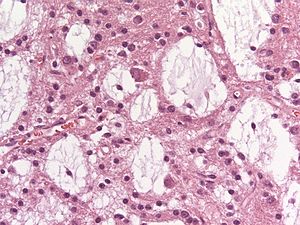
Dysembryoplastic neuroepithelial tumour

Dysembryoplastic neuroepithelial tumour (DNT, DNET) is a type of brain tumor. Most commonly found in the temporal lobe, DNTs have been classified as benign tumours. These are glioneuronal tumours comprising both glial and neuron cells and often have ties to focal cortical dysplasia. Dysembryoplastic neuroepithelial tumour (DNT, DNET) is a type of brain tumor. Most commonly found in the temporal lobe, DNTs have been classified as benign tumours. These are glioneuronal tumours comprising both glial and neuron cells and often have ties to focal cortical dysplasia. Varying subclasses of DNTs have been presently identified, with dispute existing in the field on how to properly group these classes. The identification of possible genetic markers to these tumours is currently underway. With DNTs often causing epileptic seizures, surgical removal is a common treatment, providing high rates of success. Seizures and epilepsy are the strongest ties to dysembryoplastic neuroepithelial tumours. The most common symptom of DNTs are complex partial seizures. Simple DNTs more frequently manifest generalized seizures. In children, DNTs are considered to be the second leading cause of epilepsy. A headache is another common symptom. Other neurological impairments besides seizures are not common. Dysembryoplastic neuroepithelial tumours are largely glioneuronal tumours, meaning they are composed of both glial cells and neurons. Three subunits of DNTs have been commonly identified: There currently exists some debate over where to make the proper division for the subunits of DNTs. A fourth subunit is sometimes noted as a mixed subunit. This mixed subunit expresses the glial nodules and components of ganglioglioma. Other findings suggest that DNTs require a reclassification to associate them with oligodendrogliomas, tumours that arise from solely glial cells. These reports suggest that the neurons found within DNTs are much rarer than previously reported. For the neurons that are seen in the tumours, it is suggested that they had been trapped within the tumor upon formation, and are not a part of the tumour itself. A dysembryoplastic neuroepithelial tumour is commonly diagnosed in patients who are experiencing seizures with magnetic resonance imaging (MRI), electroencephalogram (EEG). A DNT is most commonly diagnosed in children who are experiencing seizures, and when given medication do not respond to them. When a MRI is taken there are lesions located in the temporal parietal region of the brain. Typical DNTs can be detected in an EEG scan when there are rapid repetitive spikes against a contrasted background. EEG are predominantly localized with DNT location in the brain, however there are nonspecific cases in which the location of the tumour is abnormal and not localized. Dysembryoplastic neuroepithelial tumours are classified as a benign tumour, Grade I of the World Health Organization (WHO) classification of brain tumours. This classification by WHO only covers the simple and complex subunits. Groups lacking glioneuronal elements were not considered to have fallen in the same group and have thusly not yet been classified.
